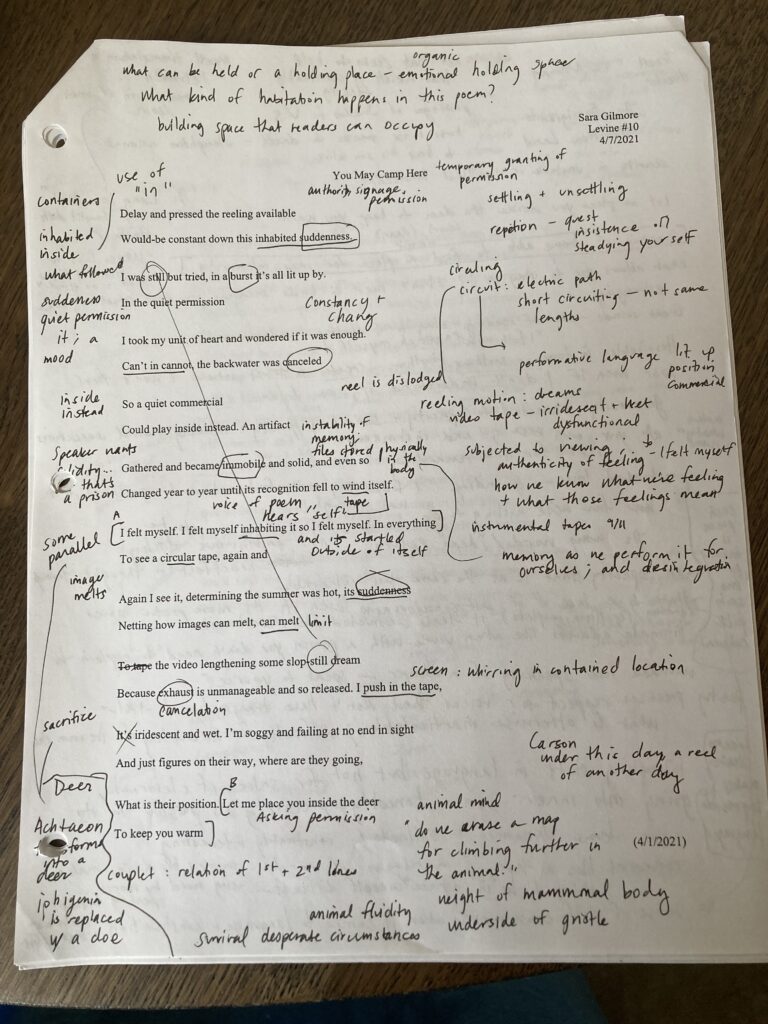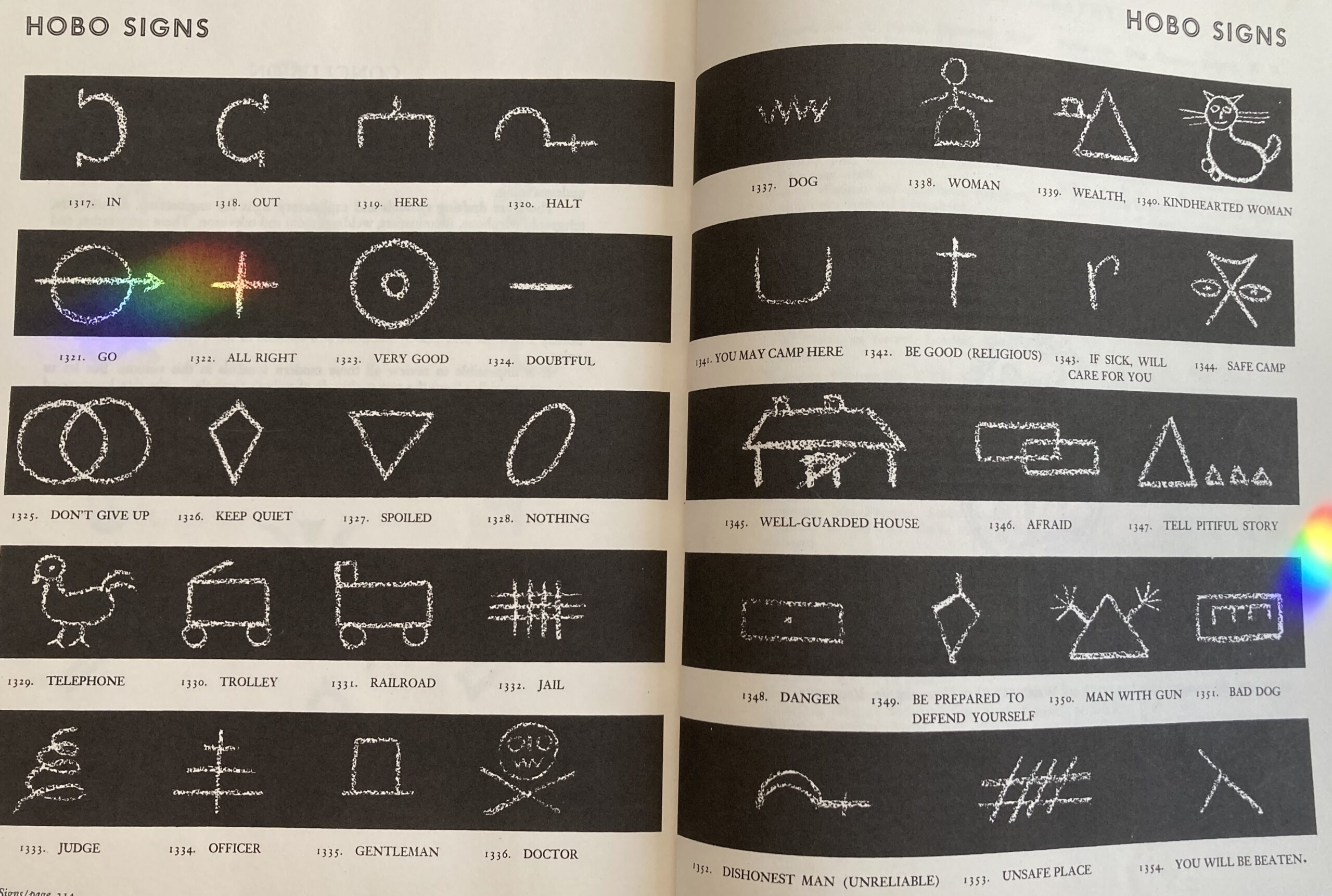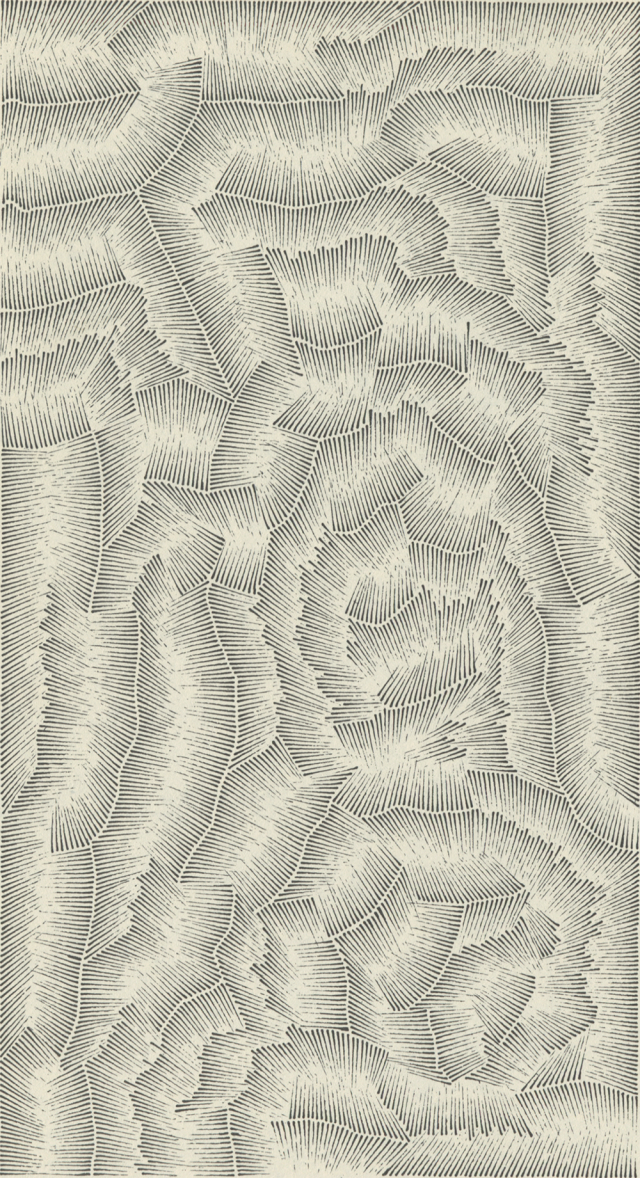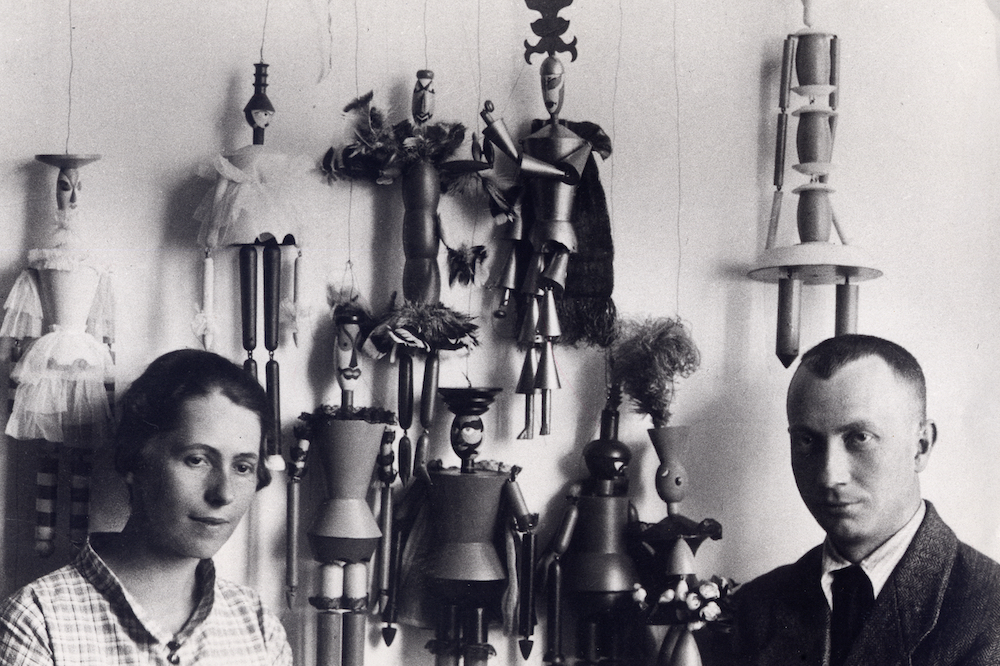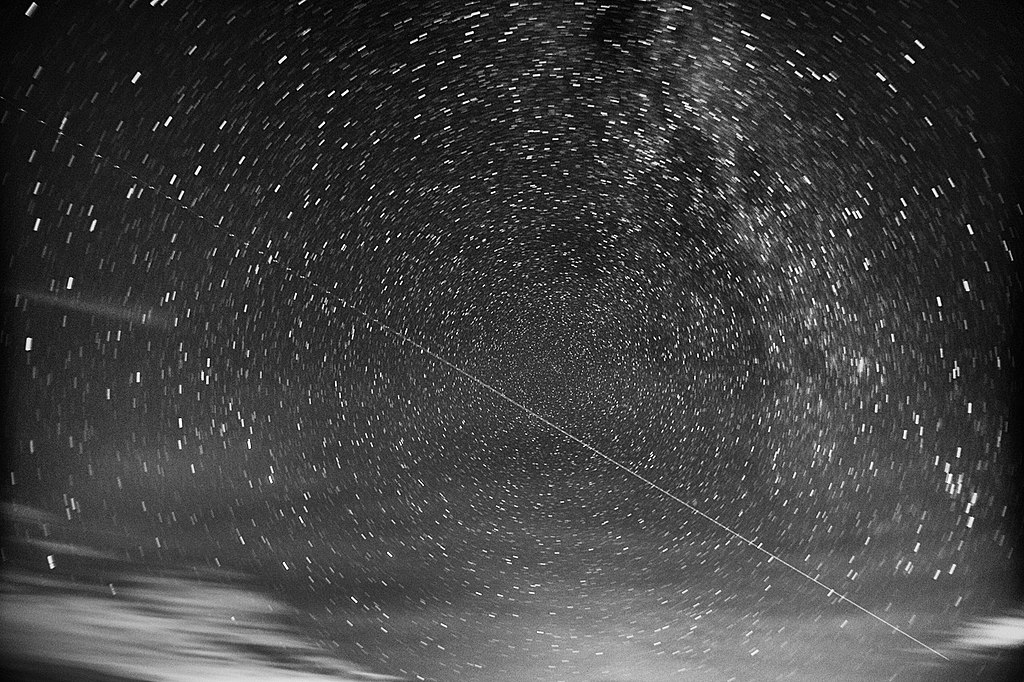From Six Drawings by Robert Horvitz, a portfolio published by The Paris Review in 1978.
The following entries came from notebooks the writer and psychoanalyst Christopher Bollas kept between 1974 and 1977. These notebooks were not written or edited for publication–Bollas says they were more like “mental scratch pads where the author simply writes out what he is thinking in the moment without, ironically, thinking about it.” The entries touch on things Bollas was reading at the time, scenes he saw in London, what he was observing in patients–and, more often than not, the ways these all intersected in his thoughts. We selected these entries in part because they cover a period of time when he was reading and thinking on and off about the work of Herman Melville, alongside many other questions about character, the self, and others.
Undated entry, 1974
Let us imagine that all neuroses and psychoses are the self’s way of speaking the unspeakable. The task of analysis is to provide an ambience in which the neurotic or characterological speech can be spoken to the analyst and understood. It is not so much [a question of] what are the epistemologies of each disorder but what does psychoanalytical treatment tell us about them? We must conclude that it tells us that all conflict is flight from the object and that analysis restores the structure of a relation so that the patient can engage in a dialogue with the object.
The style of the obsessive-compulsive, for example, is in the nature of a closed cognitive and active world. If obsessive-compulsive behavior is memory, what is being recalled? It seems to me that obsessive-compulsive behavior is a mimetic caricature of rigid mothering. It is caricatured self-mothering which [may] recall [interpret] the mother’s handling of the child.
How else can we account for the shifts in disorders if we don’t take into account the paradigms which generate them? Insofar as we know that patterns of mothering vary historically, can’t we assume that each disorder remembers the primary object relation? Indeed, why else does psychoanalysis go back to childhood when presented with conflict? Because it is understood by most to be functionally derivative of infancy.
The only problem is that the philosophical assumptions of this hypothesis remain unappreciated, to wit, all disorders speak the individual’s past and they ultimately speak the subject’s interpretation of the past and therefore are a form of remembering. The advantage of this to the person is to value his disorder as a statement, not simply a dysfunction. This is the difference between the hermeneutic and functional traditions of psychoanalysis.
A symptom is a way of thinking. Remembering is a way of thinking. Symptoms are some form of the subject’s thinking about himself. Psychoanalysis is a way of two people thinking together about one person’s thinking.
A patient brings a mood, thought, confusion, a blank—collages of himself—and the analyst provides the space. The therapeutic alliance is simply: we are thinking and working together. The transference and countertransference: we are feeling for each other together.
Undated, 1974
“American literature”
American writers speak the true self, while the country doesn’t listen. Melville tries to identify with this American false self—the external explorer and conqueror—but fails and the true self breaks through.
Undated, 1974
“Ahab”
What is absolutely essential is to keep in mind that Moby Dick is an invention, a projected object. The horrid irony of Ahab’s effort to break through the “pasteboard mask” is that he is the object behind the mask! He is the originating subjectivity. Does Melville make this irony specific?
The five phantoms loosed in chapter 47 are the loosening of Ahab’s internal objects: or the objectivization of internal selves. Rage permits the dissociations to be loosed though never integrated. Rage—especially in the search for the whale—is a loosening of or an exorcism of internal objects. The whole point of the trip is to exorcise the phantoms and to put them into the whale.
Undated, 1975
It is one of the ironies of existence that you can love the other only after you have lost the other. With ego development the fusion with the other is lost, a necessary precondition for recognizing the other’s separateness, but nonetheless a losing of one’s [fused] self.
Undated, 1975
“Melville’s ethics”
At a time when the other is sought outside, as a deity, an idea, or history, Melville’s hero points toward the struggle to find other as the unconscious self. In a sense as man has destroyed culture (collective dream/play space) he then assumes the responsibility of it and comes to a point of wisdom: culture always reflected him; he created it, it came from him. The sacred, profane, shared, etc., all experienced as outside; Melville says we must experience an inside other.
Thus he has in Mardi and in Moby-Dick a transitional metaphysical and psychical moment between other as outside (the whale) while Melville gently proves it to be inside the self. It is important to see this as Melville’s ethic. Outside, there is neither solution nor absolution; nor is either ever possible. Insight, the seeing into the self, to witness and behold the other as inside is the shock of re-cognition that Melville asks of us. It is the venue of the psychoanalyst as well, but the psychoanalyst after Freud’s metapsychological works processed the other and ethically disowned it.
Free association, which was a way of access, against the resistance of man, became a means of disowning the other by processing it. A novelist like Melville searches inside himself, comes to the point of seeing and holds the fundamental fact of the internal other.
December 10, 1975
“On good interpretation as poetry”
It is the form of an interpretation that is most effective. We must know that our best interpretations are poetic in their structure and delivery, so that the form holds words in such a way as to deeply affect the patient. In the same way, poetry rather than prose gets to us in a deeper way.
January 22, 1976
Out of the debris of our dying culture (early twentieth century) comes a new mythology and a new language. We see this early in Baudelaire who finds the symbolic inside the city; we discover it in Barthes (Mythologies) who creates a new mythology. It is godless. It is ordinary. As Barrett points out in Irrational Man, cubism is the ontologizing of the banal object, because out of the debris only objects are left.
The psychoanalytical experience is, in free association, the use of the ordinary (i.e., trivial language) to remythologize the person, to find his myth, his culture, through the debris. From the debris of his own words, which up till now he has found barren, a wasteland, he discovers meaning and then his own myth.
The analyst is the person, par excellence, who carries the person through the wasteland of the self, and who holds.
Where has the debris come from?
From an explosion in the nineteenth century of human value and belief. We are commodities, objects-to-ourselves, defined by use or function.
The death of culture. Debris. Playing with debris (Dadaism). Creating a new language.
The analytic process: death of the old self; debris and the sense of dislocation; playing with the debris; searching in anger, despair; through reflection, finding one’s self.
Barrett says that before man is a being, he is a “being-in” (111): taking Heidegger’s point about Being in the World. In modern man this Being in, or the essence of our being, has been lost. It can be re-found in psychoanalysis.
In Coleridge’s “Dejection: An Ode” and in Marx’s Economic and Philosophical Manuscripts we see man expressing his sense of loss of being-in the actual world. We have seen this earlier with Pascal, though in his situation it was as much the losing of a spiritual world: being in a world of spirit. Being-in spiritually (mythically) and Being-in actually (materially) have been severed. It is this loss which writes the “Wasteland” and founds existentialism.
Out of this comes man and world as debris, cut up in Dada and Joyce, and now a new myth of man emerges. What is the new man?
The silence of the patient comes after despair over the word. They have said, perhaps, a great deal, but begin to have a feeling of despair over the word. This despair sponsors a silence; it is silence in the face of the unthinkable; the absence in the core of a person over a truly spontaneous sense of being-in the world. Their speech has been a narrative account, a construction, often beautifully or bravely rendered.
The patient of today can speak only for so long. Speech is an effort. It is an attempt to hold off the void. (Pascal.) The silence denotes emptiness and the absence of the other. The analyst must be absence coming eventually into presence through holding.
We focus on the mother as the cause, but in fact, she is all that is left of one who gives meaning, breathes life into the other, and so we focus on her. She can never make up for the void in the culture. Our search into this relation, solely, is a misdirected one.
Character and creation. Our being does have voice through character. To hear it is a task, painful, awful. It is the voice of our emptiness yet through the transference—the analytic paradigm—our character changes.
In Moby-Dick the myth explodes (capitalism, Protestantism). We are left with Bartleby, mute among the debris—dead letters. The Confidence-Man remythologizes by manipulating the ordinary into the fantastic. He picks up debris and maps the fantastic.
After 1914 man learns, according to William Barrett, that the solitude of being a self is irreducible regardless of how completely we seem to be part of a social milieu. Man is no longer contained in a social fabric. But with our patients the tragedy is that each must fashion a life out of a wasteland.
In the sixties, politics, group movements, the therapies, communes, etc., were all attempts to fashion cultures. The Beatniks (Kerouac, etc.) were the first.
It is silly to say “counterculture” as there was no culture there in the first place.
Each of us carries within our own debris. It is our past: a past not held within a familial, social, and cultural container to be given recurrently back to us. We don’t know our past. We only have images, memories, pictures etc. We bring this flotsam to the analyst who gathers the pieces; he gives form to our content—if we can trust him to do this—we find our past. This is the analyst as the transformational object: the one who gives form to our content and thereby transforms the content itself, by giving it meaning.
Out of the debris of our past emerges our own mythology. Why have I been so moved when on one bright day I witnessed from a 10,000-ft. peak of the Sierra Madre a tiny train thousands of feet below crossing the California desert? Why should this experience be so close to me, seem to hold me? It was a question, in fact, that I had never asked at the time. Its essence evaporated into the diversions of my life, though now and then I recovered it.
In analysis I found two things about myself. One was that, as my father had gone off to war when I was three months I did not see him until I was nearly two. I was overly eager not to see my mother disappear as well. At nursery school, it was my fate to stand up high on the steps of the slide—not to go down—in order to watch in the distance for the first sight of my mother who would come to collect me.
So being up high and searching for something vital and joyful was part of my personal idiom: the creation of my myth of significance and order.
The other mythical object was the train, which has always filled me with sadness and, strangely, contentment at the same time. So it was in my analysis that I discovered that it was by train that I left my birthplace and my father and also it was to the train station that every day my grandfather took me to see the train go by. Perhaps he did it out of his own love of trains or perhaps it was because I indicated my desire to see trains and he, in kindness, facilitated this wish. What the myth of trains gave to me in analysis, with the understanding of the essence of the aesthetic experience on the mountaintop, was how an experience visualised for me a deep myth: searching for recovery from my mother, longing to be reunited with my father. The experience of looking on the mountaintop was me.
May 9, 1976
“Metaphysical psychology”
Is it the eventual affirmation of the negative? Is Moby-Dick an affirmation of brotherhood, through the destruction of isolated fanaticisms? Ishmael lives to share a narrative with others, unifying men through discourse, while Ahab uses men to fulfill the fantastic demands of his private culture.
November 4, 1976
“On a character serving in a restaurant”
I am watching a young woman who is the waitress (wife) in an artificially lit Italian café that serves sandwiches to the English. The surroundings are without character, rather like the set of a television film, suggesting its impermanence. There is little here, except the come and go. The first time I ate here, she paid me no attention—flung the food on the table. Yet, tonight, I have discovered her use of herself as a character. She dissociates from the surroundings, defying the anomie by being a character. She throws her hands through her hair, punches out the orders, laughs or teases the locals—yet she is totally self contained. I find this interesting as I am reminded of Marx’s theory of alienation. She deals with it all by laboring her character: it becomes the surrounding of the self, and she looks no further.
Undated, 1977
“The text dreaming”
The text would have to undergo an experience of its own dream. Like the dreamer, the text would have to be confused. It is not simply the author who has the dream as the dream elements are already in the text at hand. With Stubb’s dream I must see what holds up to the dream and then what occurs after the dream.
The point is to establish the composition of the dream space, in literature or in life. It is an area of
1. Wonder or terror
2. Actualization
3. Enigmatic meaning
4. The place where the thinker is the thought of himself, or, the thinker the participant in the thought
The dream in literature must be a region of wonder, separate from yet reflexive to the rest of the text. It must be the dream’s text, as it must use and pit itself against the text, in order for us to consider it as a dream. A space in relation to the context of events in the fiction. Is it an allegory within an allegory?
What is the difference between a vision and a dream?
I am concerned with a text which has a dream, a moment when the continuity of its presence of mind is interrupted by a dissociation in its consciousness, in a space that I have called the dream space. The text can have its own dream if at this moment the cumulative experience of imagery-making, of plot construction, of characterization, breaks down into a self-reflexive dream process. This is rather like a breakdown, but a breakdown of a very special kind. In such moments the author yields, under the demand of the text’s unconscious logic, to the text’s (and his) need to share a dream with each other. (So, the author shares a dream with his text!) We could say that this moment will be more available in the modern novel, where the author already has found an intimacy of rapport with the text, where he uses more the idioms of his own internal psychic structures than the conventions of literary creativity. Even so, few authors—as Poulet insists—achieve a level of sincerity toward their own text. I should say, an intimacy where the text is the container of unintegrated subjectivity, and where the author’s Other is not an alienated moi, but a subjective object.
To the person writing or dreaming, writing (or textualization) and dreaming are processes of thinking about being, not products. We must, as E. Said argues, reacquaint ourselves with writing as a process, not a finished product.
This can also happen because an author, like Melville, needs to dream within the text; though the experience of the dream will be in the textual space, will use the history of the text for the dream material, and, as such, will be the text’s dream. If an author, like Melville, yields himself to the text, then we can say that the text will dream him, or dream about him.
April 26, 1977
“Melville”
The core fantasy seems to be of a desire for an object to be plundered. In Moby-Dick this was the whale, but this leads to annihilation. In “Bartleby” there is a desire for the experience to be provided by the other (the employer), with a dead ending in the brick-wall prison. In “I and My Chimney” there is an attachment to the object as inanimate and under the fantasy control of the self.
What can we call this cluster? It is a private phantasy: an autistic phantasy that materializes within the fiction, but isn’t made explicit as such. In “Bartleby” it is addressed to the other. In Pierre what do we make of the episode when the character crawls under the rock, to be born again? Is that another cluster? Is the fictional space a place where Melville can have this phantasy? An autistic voice?
May 2, 1977
“Melville”
Literary perversion.
Idiot event.
Burlesque.
Are there certain fantasies of the text that are not thoughts per se but ritual enactments of ego structures? Deep memories, paradigms, of the subject’s experience of the other?
Is an allegorical personification a character? Insofar as this structure speaks structurally, it is.
The idiomatic arrangement of character structures is the voice of character: the interpretation of self.
Does character speak in fiction more uniquely as the other becomes a phantom (death of God) eliciting a mute yell from the subject—as the voice of character? All character is utterance to an absent other, and with the death of God, this absence provokes deep language cries.
In some characterizations—especially sagas—we must ask, What is left out? The character may be noble, set against a surrounding world that is very violent. This is the split-off voice of character, which in the nineteenth century is joined to the self. Character defends the self against the internal world.
How does character relate—i.e., to us, the objects around it? Such use, does it reveal idioms?
The absence of a specific character language, particularly the person who seems to be strong and induces our projective identifications, creates a dream space for us. Character is the container of the reading subject’s pure self. We are Other.
May 3, 1977
“Character in fiction”
Does character in fiction depend on what the hero deals with or transforms? Where are the events of being? Character has to do with the idiom of transformation: an interpretation of the self. Where is the locus of transformation in fiction: in the author, or, is it yielded over to character?
What is the relation of character to the author’s use of character?
Character in fiction is a type of speech which may or may not occur in fiction. It is an interpretation of the self. If it is only a rhetorical device, it will only be interpreting the self as a rhetorical act. However, if the self experiences an internal world and relating, then character speech may occur as a reading of that self.
Rhetorical versus psychological character.
How do we experience the character in fiction? Or, how do others [other characters in a novel] experience the character in fiction? He is set up in others and in the reader. Is the text, the Other for the character? Does it reply to him or hold him?
Does character reflect the mental process of the text? Is character an interpretation of being inside the text? Where text is the psychical process, does character interpret this?
Undated, 1977
“Character”
Character in a text expresses something. Invariably, it is the discourse of structure, of handling by a self, and is a different hermeneutic. A character may say “I love you” but the formality of his being may say “Only at a safe distance do I love you.” This speech is the discourse of character and is a subjective interpretation of the self rather than the professed themes uttered by the subject. Think of Heidegger’s notion of the existence-structure of the self. Ishmael and Ahab transform the subject “I will hunt the whale” in different ways. Their style of handling is an interpretation of the self. It will speak fundamental paradigms of transformation of need, desire, fear, etc., of instincts and relating to the object. When an author releases different characters into fiction he is releasing varying ego structures in himself, different selves, to personify aesthetics of being.
“The Aesthetics of Being: Character as Discourse on the Self.”
We cannot decenter character from the crucial reality that there is an interpretive presence in character. The structures of character are idiomatic internalisations of self-object (and self as instinctual presence as object) relations. These are matters of choice. Ishmael and Ahab make choices derived from their different ego structures.
By releasing character the author uses different styles of transformation of desire and relating to the other.
In fiction, each character embodies a character memory.
Does any of it have to do with the experience of the text? In the sense that an author may release his internal world into the text, characters are different modes (ego structures) of handling and interpreting these themes. This handling (transformation) is the aesthetic of character.
Ego structure. The infant experiences the mother. On the basis of the infant’s experience of the mother he makes choices about handling the mother.
In Moby-Dick Melville puts one ill and one healthy ego structure alongside one another, in the juxtaposition of Ahab and Ishmael.
The mother’s handling of her infant is an aesthetic and points the way to her notion of the baby’s body and self. Her handling complements the baby’s emergent ego (handling) functions. As the mother handles instinct and impulse, so the baby internalizes her paradigms. This is the internalization of an interpretation of the self.
Undated, 1977
“Metaphor as secret”
Metaphor takes a word which applies to one thing and transfers it to another because it seems a natural transfer. This occurs in Melville’s pyramid fantasies where clusters of metaphor sequester hidden meanings. The chimney has hidden spaces and is a metaphor of secret places. Such an act is at the root of fiction. Keeping the source a secret, yet communicating from it. Is it some deep ego structure that finds symbolic equations for itself?
Undated, 1977
“Character versus subjectivity”
Character is memory. It is an aesthetic of being that forms and transforms experience according to an unconscious hermeneutic. It is mute in the sense that the receiver is absent (except in analysis) and the subject who enacts his character is blind and deaf to his aesthetic.
In a sense, character reserves an interpretation of being that may be at variance with the person’s subjective notion of their essence. It is a clash between the discourse of character—which speaks through the aesthetic of being—and the voice of desire: the subject’s play of the imaginative possibilities of self.
This is, perhaps, best illustrated in a person who is (as existent-structure) a certain way. He handles himself and others in a certain style. A syntax of being and relating. Now, all this may be unknown by the subject and, indeed, at wild variance with his own “internal world” or, at least, his experience of the world.
It raises the question: What is subjectivity? Or, can there be a genuine subjectivity without hearing from the discourse of character? I think the discourse of character is a mute speech. It means “listening” to one’s silent speech, almost as if we bear with us a shadow self who prints in an aesthetics of being a dialogue with an absent object. In psychoanalysis, this absent object may reappear in the transference.
In fiction, at least the modern novel, character may exist alongside consciousness; in particular, the consciousness of the author … or the world of the novel. What is the discourse of the self? Does the consciousness of the author grapple with the violence of character; or, is it remedied by superficial placing in indexical tongues (sociological matrices) rather than as an idiomatic—unconscious—discourse of the ego: the impersonal self?
What novels do I know of where the subject grapples with character? Moby-Dick, Crime and Punishment. It means a conscious confrontation with the mute determinacy of one’s idiomatic discourse. Character is autistic, in that the receiver of the discourse is absent (the object of all characterological defenses) and the language is, thereby, a dead language. It is the fact that character is a dead language—a language no longer spoken between the original speakers—that gives critics the sense that character is conservative, or inhibiting.
Most novelists understand only the effect of character—that is, linking it with mute determinacy—and this principle is then reprinted in a novel, in social terms (cf. Goffman), but that is not the truth of character, which is deeply enigmatic and aggravating.
Many novels are an attempt to escape the enigma of character by a manic-omnipotent staging of character, giving to themselves a control over character—“characterization”—that is a denial of the very experiences of one’s character.
Recent psychoanalytical studies of the self—in particular, the borderline and narcissistic—are concerned really with a patient whose primary speech is character, whose “subjective” life is blank or chaotic and who refuses to be informed as a subject, of themselves as a character.
Character is destiny if understood, and fate if not understood.
Few authors permit this determinacy to be with them. Their act of omnipotent creation defies destiny. Yet some writers do: Melville, Shakespeare.
December 15, 1977
“Denial and paranoia”
A patient denies memory and both severs and dissolves linking, so he has no internal, accrued sense of self. He has no tradition upon which he can rest. His unconscious motivation is to deny the absence of a transformational object and to reject what is, to use the semiology of the self as a reproach to the other, who must feel guilt.
But, the attack on linking leaves him without structured psychological means of living-in-the-world. To survive, he uses paranoid vigilance—to scan the environment—instead of psychic insight, to know the self. Hence, paranoid thinking is a defense against anxiety surrounding survival of the self, that occurs when there has been an unconscious subversion of psychological insight. That is why he is not concerned with knowing himself or with insight, but only with how I feel about him and whether he is in trouble or not.
Christopher Bollas is a psychoanalyst and writer whose books include The Shadow of the Object, Cracking Up, and Meaning and Melancholia, among others. This extract is adapted from Streams of Consciousness: Notebooks, 1974-1990, which will be published by Karnac Books in England in October.
